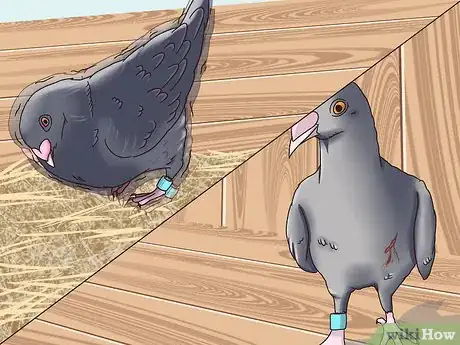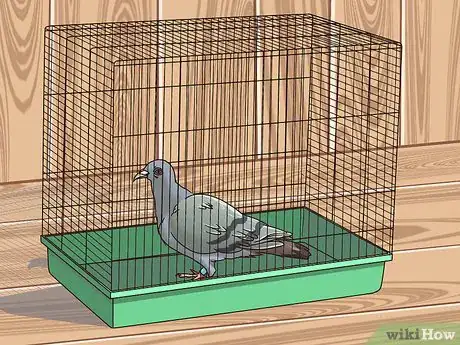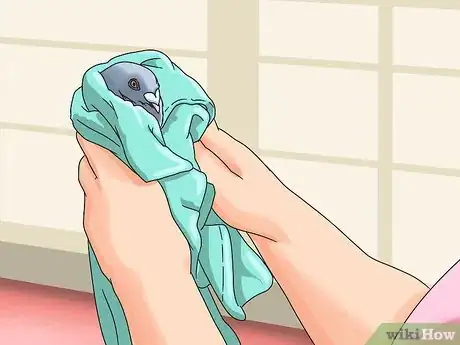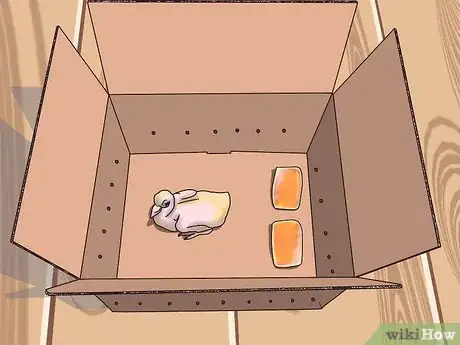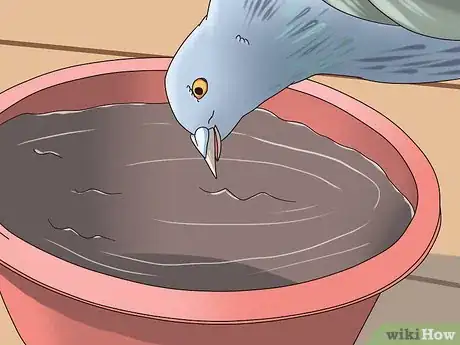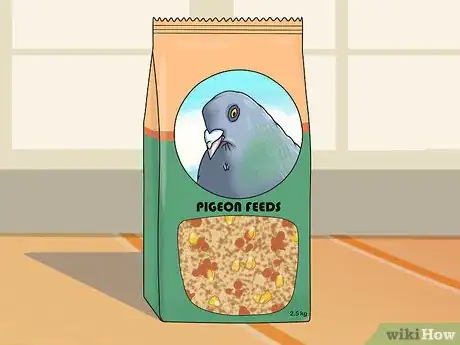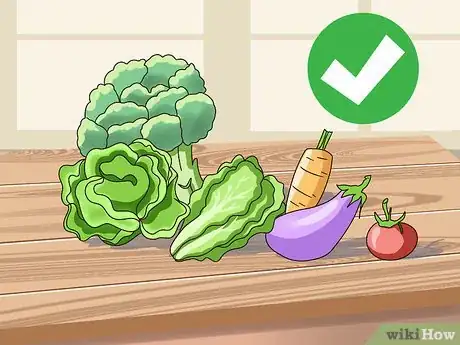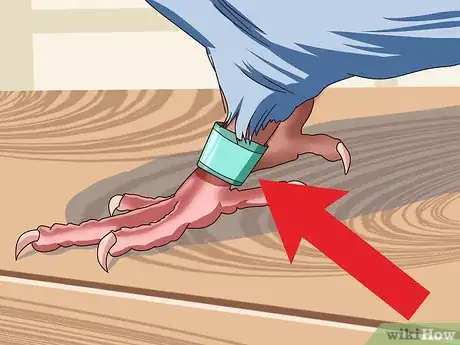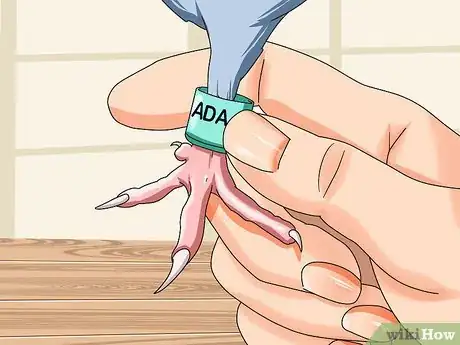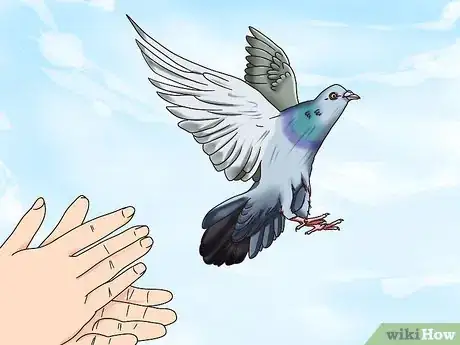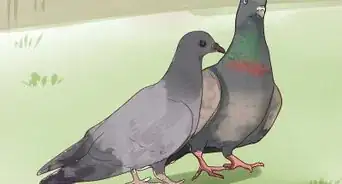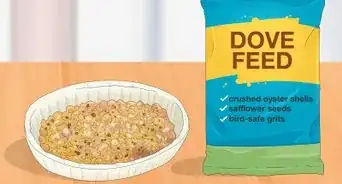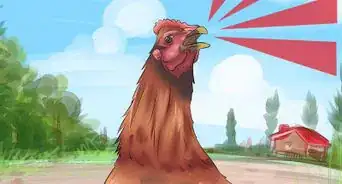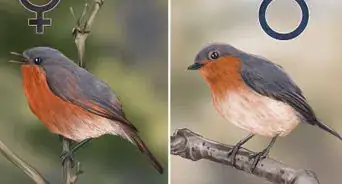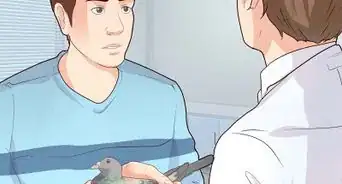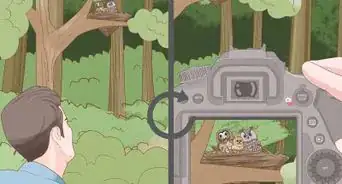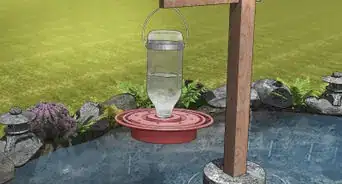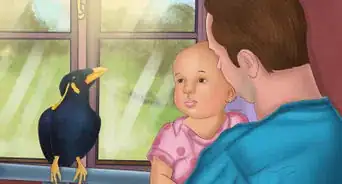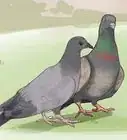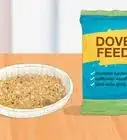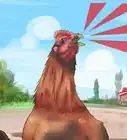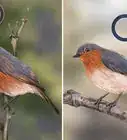This article was co-authored by Pippa Elliott, MRCVS. Dr. Elliott, BVMS, MRCVS is a veterinarian with over 30 years of experience in veterinary surgery and companion animal practice. She graduated from the University of Glasgow in 1987 with a degree in veterinary medicine and surgery. She has worked at the same animal clinic in her hometown for over 20 years.
There are 10 references cited in this article, which can be found at the bottom of the page.
wikiHow marks an article as reader-approved once it receives enough positive feedback. This article received 13 testimonials and 92% of readers who voted found it helpful, earning it our reader-approved status.
This article has been viewed 127,837 times.
Taking care of a lost pigeon requires providing food, water, and shelter. If you have found a racing pigeon, try to find the owner. If you have found a wild pigeon, help the pigeon get healthy and then release him back to the wild.
Steps
Housing the Pigeon
-
1Seek urgent care. If the pigeon is shaking, bleeding, or vomiting, immediately take him to an avian veterinarian. If you are not sure where to take the pigeon, call the WildCare Hotline at (415) 456-7283. They can also tell you how to care for the pigeon.[1]
- Always seek urgent care if you have a baby pigeon. If the pigeon makes any type of squeaking or chirping sound, you have a juvenile pigeon.
-
2Get a ventilated box or cage. A small cardboard box or a bird cage can be used to house the pigeon. If you use a cardboard box, poke small holes in the side of the box for ventilation. You could also place a screen on top of the box for ventilation.[2] Line the bottom with a soft cloth or some paper towels.[3]
- An ideal cage would be at least 42″ wide, 27″ deep, and 30″ high. You can also use a small dog or cat crate.
- Any container that you use should protect the pigeon from any cats or dogs.
Advertisement -
3Capture the pigeon. If the pigeon is tame or injured, you should be able to pick the pigeon up with your hands. If you can't pick the pigeon up, try throwing a towel over the bird and then scoop the pigeon in the towel and place it in the box. You can also use food to bait the pigeon into the container.[4]
- You can also walk behind the pigeon to get him to walk into the container or into a place where you can easily catch him.
- Grab him across the back and gently hold him with two hands.
-
4Care for a baby pigeon. If you have a baby pigeon, place him in a ventilated box with the heating pad turned on low. Half of the container should be heated and the other half should not. Baby pigeons have a special diet. Call the WildCare Hotline to get instructions to care for the pigeon and find a hospital or veterinarian for the baby pigeon.[5]
- Call the number before you feed the pigeon. Improper feeding can result in death or a serious injury.
Feeding the Pigeon
-
1Give the pigeon clean water. Put water in a container that is at least 1 inch deep (e.g. old margarine tub). Water is more important than food if a pigeon is lost. The pigeon may be exhausted and not recognize the water. If you notice that the pigeon is not drinking, dribble a few drops of water into the container to make a splashing sound.[6]
- If the pigeon looks super exhausted, put a teaspoon of Gatorade in two cups of water and give it to the pigeon. This will help replace lost electrolytes.
-
2Purchase pigeon feed. Pigeons eat grains and seeds. Go to a feed store to purchase pigeon feed. Pet stores usually do not carry pigeon feed. If you cannot go to a feed store, you can buy wild bird seed or dove and quail mix from the pet store.
- You can also give the pigeon uncooked popcorn, rice, split peas, barley, and buckwheat. Do not give your pigeon a slice of bread.[7]
- Start by giving 2 tablespoons in the morning and see how much the pigeon eats. Adjust the amount until all of the food you provide in the morning is gone by the end of the day.
-
3Provide vegetables. In addition to grains, your pigeon will enjoy eating vegetables 3 or 4 times a week. Chop or mince vegetables such as carrots, broccoli, snap peas, kale, cauliflower, dandelion greens, edamame, and bell peppers. Wash the vegetables to remove any chemicals before you feed them to your pigeon.[8]
- The vegetables should be placed in a small, separate dish.
- Start out with 2 tablespoons and reduce the amount based on how much your pigeon eats.
Returning the Pigeon to Its Owner
-
1Check for a leg band. If you have found a racing pigeon, they will be wearing a leg band. The band will tell you where the bird is registered, the year the bird was hatched, the pigeon club, and the pigeon's unique number.[9] Some bands may have the owner's name and contact information. If the bird does not have a band, it is a wild pigeon.
- If the leg band has the owner's contact information, contact the owner and let them know that you have their pigeon.
- If there is no contact information, you will have to read the leg band to determine who to contact.
-
2Read the leg band. The first 2 letters of the leg band will let you know which national organization that pigeon belongs to. You can then contact the organization and let them know that you have found one of their pigeons. All of these organizations have websites. Here are some common organizations:
- AU stands for the American Racing Pigeon Union.
- CU stands for the Canadian Racing Pigeon Union.[10]
- IF stands for International Federation of American Homing Pigeon Fanciers.[11]
- NPA stands for the National Pigeon Association.[12]
- If the band says “IFB” call 1-877-355-7727 or email them at foyspigeon@zoominternet.net.
- ADA stands for the American Dove Association and you can contact them at secretary@doveline.com.
- If the band has letters that you cannot identify, contact the American Racing Pigeon Union. They will help you find the owner.
- The Vancouver Poultry & Fancy Pigeon Association will also help you locate the owner if you are unable to do so. Email them at info@vancouverfancypigeon.ca.
-
3Release a wild pigeon. If the pigeon does not have a leg band, it is most likely a wild pigeon. Do not keep a wild pigeon as your pet. It is better to take care of the pigeon for a few days until you can get him some help at a rescue society.[13]
- Most pigeons can find their way home after 1 or 2 days of rest, food, and water. Take the bird to an area without electrical wires and plenty of open space and release the pigeon.[14]
- Again, you can call the WildCare Hotline at (415) 456-7283 to find a rescue place for the pigeon. Avoid calling your local humane society. They are more likely to euthanize the pigeon instead of providing care and releasing him back into the wild.[15]
References
- ↑ http://www.pigeonrescue.org/resources/in-case-of-emergency/
- ↑ http://www.pigeon.org/carelostbird.htm
- ↑ http://www.pigeonrescue.org/resources/in-case-of-emergency/
- ↑ http://www.pigeonrescue.org/resources/in-case-of-emergency/
- ↑ http://www.pigeonrescue.org/resources/in-case-of-emergency/
- ↑ http://www.pigeon.org/carelostbird.htm
- ↑ http://www.pigeon.org/carelostbird.htm
- ↑ http://www.vcahospitals.com/main/pet-health-information/article/animal-health/pigeons-and-doves-feeding/918
- ↑ http://www.pigeon.org/lostbirdinfo.htm
About This Article
To take care of a lost pigeon, seek urgent care from an avian veterinarian if the pigeon is shaking, bleeding, or vomiting, or if you've found a baby pigeon. If you've found an adult pigeon that doesn't need immediate medical attention, place it in a ventilated box or cage, and provide it with fresh water and pigeon feed. You can also feed the pigeon uncooked popcorn, rice, split peas, barley, and buckwheat. Also, give the pigeon chopped or minced vegetables 3-4 times a week. For more tips from our Veterinary co-author, like how to find a lost pigeon's owner, scroll down!
